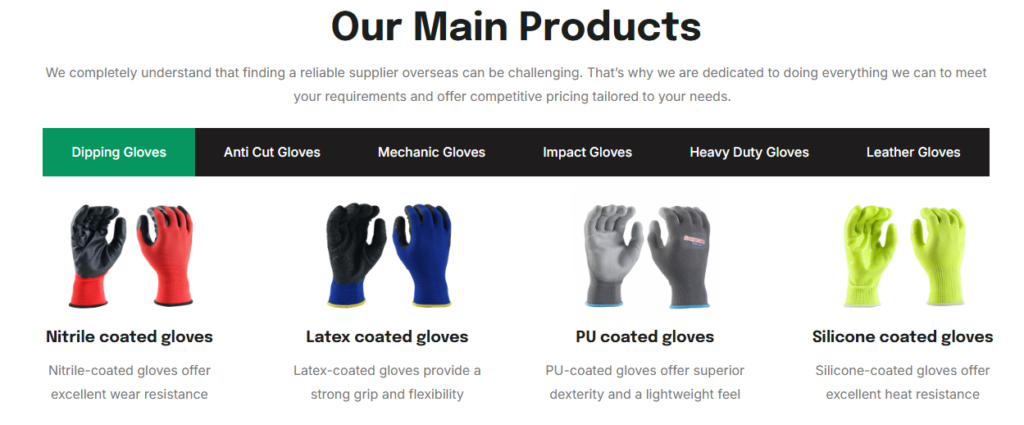Choosing the right work gloves can be tricky. With so many options available, it's hard to know which one fits your needs best. In this post, I'll guide you through the process to make sure you pick the right gloves for the job.
When choosing work gloves, it’s essential to consider the material, the protection level, and the task at hand. Proper selection ensures both safety and comfort.
But with so many types and features, how do you narrow it down? Let's take a closer look at the best ways to pick work gloves, based on your specific needs.
How to pick work gloves?
Not all gloves are created equal. Different tasks require different gloves. Here's how to figure out which type will protect you best.
Start by identifying the specific task you'll be performing. The right gloves should protect you from hazards like cuts, punctures, and chemicals.

When selecting work gloves, think about these key factors:
1. Material
- Leather gloves are durable and great for handling rough materials.
- Rubber gloves provide protection against chemicals and liquids.
- Cut-resistant gloves are ideal for handling sharp objects.
- Cotton or knit gloves are breathable but offer minimal protection.
2. Protection Level
- For tasks that involve heavy machinery, you’ll need puncture-resistant gloves.
- If you’re working with chemicals, gloves rated for chemical resistance are a must.
3. Comfort
- Make sure the gloves fit snugly but aren’t too tight, as discomfort can reduce efficiency.
- If you’re going to be wearing them for long hours, go for breathable materials to avoid sweat buildup.
4. Grip and Dexterity
- For tasks requiring precision, look for gloves that offer a good grip without compromising your dexterity.
How do you choose the right gloves?
Choosing the right gloves means assessing the hazards you'll face and matching those with glove features.
To choose the right gloves, match the glove features to the specific task. Consider factors like grip, material, and protection level.
When deciding on the right gloves for a task, you have to consider the environment and job requirements. Here's a breakdown of the factors that should influence your decision:
1. Task-Specific Protection
- Construction: Heavy-duty gloves with extra padding and abrasion resistance are necessary.
- Electronics Assembly: Opt for thinner, more flexible gloves to handle small parts while protecting your hands.
- Chemical Handling: Choose gloves rated for chemical protection like nitrile or latex for superior defense against hazardous substances.
2. Environmental Conditions
- If you’re working in cold conditions, insulated gloves will help keep your hands warm while providing protection.
- In hot environments, consider heat-resistant gloves that can withstand high temperatures.
3. Glove Fit and Comfort
- Gloves should fit snugly but not too tight. You’ll need to maintain full range of motion for certain tasks.
- If gloves are too loose, they can become cumbersome and reduce efficiency.
What work gloves do I need?
With so many different types of gloves, how do you decide which one is best for your specific needs? Let’s break it down.
To determine the right gloves, you need to identify your primary task, the risks involved, and how much dexterity is required.
The glove you need depends entirely on the work environment. Here’s a more detailed look at the best gloves for specific industries:
1. Construction Industry
- Heavy-duty leather gloves are perfect for those in construction, offering durability and protection against sharp objects and rough materials.
2. Warehouse & Transport
- Gloves that offer both cut resistance and puncture resistance are key here. A good choice would be Kevlar-lined gloves, which combine strength with dexterity.
3. Chemical Handling
- If you handle toxic substances, you’ll need gloves that offer chemical protection. Go for nitrile or PVC gloves, as they’re both durable and resistant to a variety of chemicals.
4. Gardening & Outdoor Work
- For tasks like gardening, lightweight rubber or cotton gloves work well, as they allow for mobility while still protecting against abrasions.
5. Electronics or Fine Work
- For intricate tasks like electronics assembly, disposable latex or nitrile gloves offer the precision needed without sacrificing protection.
What is the OSHA glove selection?
The Occupational Safety and Health Administration (OSHA) has set guidelines for choosing the right gloves to protect workers from common hazards. Here’s what you need to know.
OSHA’s guidelines focus on choosing gloves based on the specific hazards present, including cuts, chemicals, and extreme temperatures.
Dive Deeper sections for h2:
OSHA’s guidelines for glove selection emphasize both safety and practicality. Let’s dive into the key recommendations from OSHA:
1. Hazard Assessment
OSHA stresses that you should first conduct a hazard assessment. This involves evaluating the types of injuries that might occur during the job, such as:
- Cut and puncture risks
- Chemical exposure
- Heat or cold stress
2. Glove Material Matching
Once hazards are assessed, choose gloves made from materials that protect against those hazards. For example:
- Chemical-resistant gloves for handling hazardous chemicals.
- Cut-resistant gloves for handling sharp tools or materials.
- Heat-resistant gloves for working in high-temperature environments.
3. Proper Fit
OSHA also recommends that gloves should be well-fitting. Gloves that are too loose can become a safety hazard, while tight gloves can lead to discomfort and reduced productivity.
Conclusion
Choosing the right work gloves is all about understanding your task and the specific risks involved. By considering material, fit, and protective features, you can ensure the safety and comfort of your workers.
